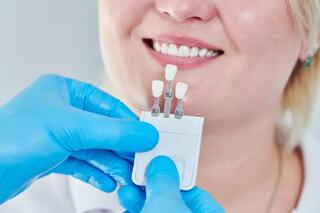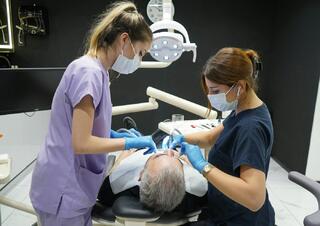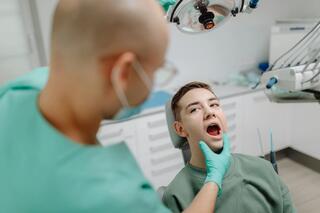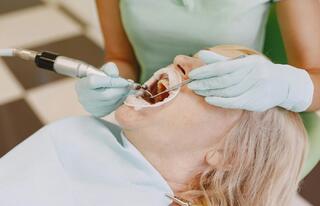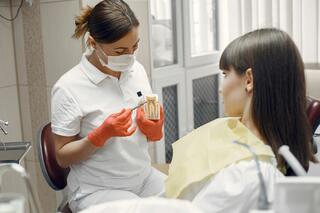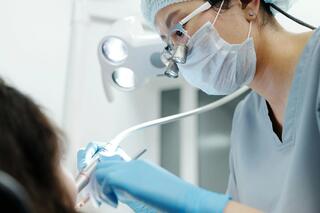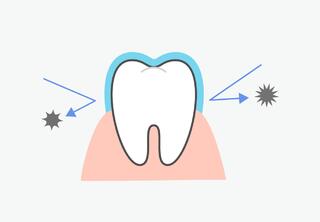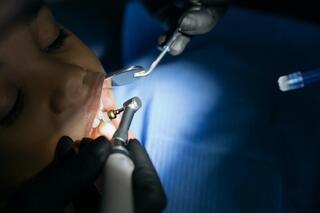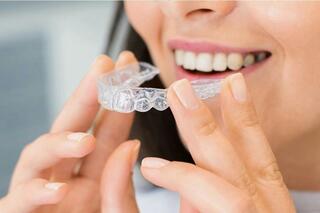At Dental Portal, we present a thorough overview of permanent tooth restoration. We explore various types of restorations, including bridge-like prostheses, crowns, veneers, and implants. You will learn about the reasons for their application, the benefits, and materials such as zirconium and ceramics. The article also highlights important aspects, including the lifespan of these restorations and their cost.
Fixed Prosthetic Solutions – An Overview

Fixed prosthetic solutions are focused on reconstructing the complete dental arch using stable orthopedic structures. This approach is key to regaining an attractive smile, averting changes in jaw structure, and preventing mouth diseases.
The choice of structure varies based on clinical needs:
- Bridge-style restorations – used when there is a gap of 3-4 teeth
- Crowns – applicable for either partially or fully damaged natural crowns
- Inlays – ideal for the repair of both the outer and masticatory surfaces
- Veneers – chosen for enhancing aesthetic appeal
- Implant-supported prostheses – designed to avert the deterioration of bone structure
Situations Warranting Fixed Prosthetic Solutions
- Teeth grinding (Bruxism)
- Extensive damage or partial deterioration of the natural crown
- Excessive wear of teeth
- Inborn developmental irregularities of the teeth and jaw structure
- Missing teeth resulting from removal or significant injury
- Cosmetic imperfections not amenable through dental cleaning or fillings
Benefits of Fixed Prosthetic Solutions
- Secure attachment within the dental arrangement
- Prevention of dislodgement during speech
- Brief period for recuperation
- Balanced distribution of masticatory pressure
- Extended durability — ranging from 10 to 15 years
- Capability to consume hard foods without concern for structural damage
Categorization
Fixed dental prosthetic solutions are categorized according to their composition material, anchoring method, and structural design.
According to Anchoring Method:
- Cement-based fixation. This method involves placing crowns and bridges on the supportive structures within the dental arrangement. The cement creates a strong bond between the orthopedic item's material and the tooth's internal structure.
- Screw-based fixation. This approach is mainly utilized for fixed prostheses that rely on implants for support. A screw is fastened into the abutment through the crown, followed by filling the opening.
Based on Purpose and Extent of the Issue:
- Partial Coverage. Addresses both singular and multiple gaps in the dental arrangement.
- Complete Coverage. Applicable for cases with a complete absence of teeth in the jaw.
- Temporary Solutions. Light, fixed prostheses for adaptation or individual acrylic crowns used during the implant bonding period.
- Long-term Solutions. Robust metal-ceramic or zirconium teeth that substitute temporary versions following the integration of titanium supports into the bone structure.
Types by Base Material
- Zirconium: Crafted from premium, colorless zirconium dioxide metal with a ceramic finish, offering robustness and a natural, transparent look.
- Pure Ceramic E-max: Made from highly durable pressed ceramic, these metal-free E-max crowns are at the forefront of modern aesthetic dentistry.
- Metal-Ceramic Blend: Comprising a base of chrome, nickel, and cobalt alloy with a ceramic overlay, these are notably strong and cost-effective compared to zirconium and pure ceramic options. Ideal for chewing area restorations, though they may cause visible metal framework and potential gum discoloration.
- Plastic: Primarily used for the anterior teeth as a provisional option while preparing for more permanent solutions.
- Metallic (chrome, nickel, cobalt): Frequently chosen for their balance of affordability and aesthetic appeal in prosthetic applications.
When it comes to the anterior teeth, dental professionals suggest opting for metal-free ceramics or zirconium. These high-quality materials are ideal for crafting a perfect Hollywood smile. For teeth primarily used for chewing, a metal-ceramic blend offers a good balance between cost and quality.
Varieties of Fixed Prosthetic Solutions
Veneers and Lumineers

Veneers and lumineers are ultra-thin layers of pure ceramics and zirconium dioxide, designed for attachment to the front surface of teeth. The application involves using a dental adhesive post the initial grinding of the tooth enamel. Sometimes, procedures like nerve removal and canal filling are required before placing veneers.
Lumineers represent an evolved form of micro-prostheses, requiring minimal tooth preparation and costing more than traditional veneers.
Benefits: They offer a naturally transparent look, creating the perfect “Hollywood smile” and ideal tooth shape.
Drawbacks: The main disadvantages include a higher price point, potential need for grinding and depulping of healthy teeth, and unsuitability in cases of extensive tooth damage.
Usage: Primarily used for correcting visible dental flaws such as chips, cracks, yellowing, and slight unevenness, particularly in the 6 upper and 6 lower front teeth.
Dental Inlays

Dental inlays, crafted from ceramic, are specifically designed for the repair of a tooth's chewing surface. These are custom-made in a dental lab using impressions taken beforehand.
Benefits: They accurately replicate the original shape of the tooth, effectively restoring its function.
Limitations: The cost is generally higher than that of traditional fillings.
Usage: Ideal for repairing teeth in the chewing area, particularly when the crown is damaged beyond 40% or when conventional fillings prove inadequate.
Dental Crowns

Dental crowns are permanent caps designed to completely reconstruct the crown portion of a tooth. They are available in a variety of materials such as metallic, metal-ceramic, zirconium, and E-max metal-free ceramic. The application involves setting them with dental cement following the grinding of the tooth's enamel.
Benefits: Crowns not only enhance the appearance and functionality of teeth but also offer protection against further deterioration.
Considerations: The effectiveness and appearance of the crown can vary depending on the material chosen.
Usage: They are versatile, suitable for both single tooth restoration and for groups of teeth, applicable to any area of both the upper and lower jaws.
Dental Bridges

Dental bridges are composed of multiple linked crowns, anchored to adjacent healthy teeth. They are constructed using materials similar to those used for dental crowns. A key requirement for a dental bridge is the presence of at least two healthy teeth flanking the area where teeth are missing.
Benefits: They effectively hide the gap in the dental row and restore the full functionality of chewing.
Limitations: The bone beneath the bridge may continue to weaken. Additionally, the process of fitting a bridge might necessitate the removal of nerves and grinding of enamel, potentially shortening the lifespan of the teeth used as anchors.
Usage: Ideal for situations where there is a loss of 1-3 teeth in a row.
Implant-Based Prosthetic Solutions

Implant-based prostheses represent the pinnacle in permanent prosthetic methods, involving the insertion of titanium implants into the bone to replace tooth roots. Orthopedic structures like crowns, bridges, or full prostheses with artificial gums are then attached to these implants.
Advanced Techniques: For cases with no remaining teeth, techniques such as "All-on-4" and "All-on-6" are employed, where a fixed prosthesis is anchored to either 4 or 6 implants.
Benefits: Perfectly replicates the look and function of natural teeth, supports jawbone health, offers excellent aesthetic results, and tends to have a longer lifespan compared to other prosthetic options.
Limitations: The main drawbacks are the higher cost and potential contraindications for surgical intervention.
Applications: Ideal for replacing any set of teeth, whether due to partial or complete tooth loss, trauma, or root damage.
Implants are superior in every aspect. They help avoid nerve removal in adjacent teeth, do not strain the supporting teeth, and maintain the health of the bone tissue. Bridges are only recommended when there are contraindications for placing implants, or if the nerve in the supporting teeth has been removed and it is necessary to protect them from destruction.
During a consultation at the clinic, the doctor will recommend a suitable option for fixed prosthetics.
Specialty of Fitting
The fitting of dental prostheses typically takes place over two appointments.
- During the first visit, preparatory steps are carried out: examination, planning, and taking impressions. It takes about a week to fabricate the prostheses in the dental laboratory.
- After a week, the patient returns to the clinic. The process of placing the prostheses averages 1-2 hours. Initially, the prosthodontist tries the structure in the oral cavity, adjusts, and secures it.
Before proceeding with prosthetics, oral diseases must be treated, professional cleaning of plaque and tartar performed, and the supporting structures prepared.
Care Instructions
Proper care for fixed dental prosthetics includes:
- Regular brushing with toothpaste and using dental floss twice daily.
- The hygiene of the spaces between teeth is enhanced with toothbrushes and mouthwashes.
- Dental check-ups and professional cleanings at the clinic every six months.
It is especially important to carefully monitor the condition of the oral cavity and follow the dentist's recommendations when dental implants are in place.
Situations Where Implants are Necessary Instead of Prosthetics
Dental implants are a dependable solution for reinstating both the appearance and functionality of the teeth alignment. This technique not only aids in reestablishing the balance of facial features but also helps in averting the degradation of the jawbone.
Right from the first appointment, our experts are capable of assessing the necessity for dental implants and advising the patient on the appropriate preparatory procedures.
Criteria for choosing dental implants include:
- Total or partial absence of teeth in either or both jaws
- Insufficient jawbone mass
- Abnormal looseness of teeth
- Injuries that affect the root portion of teeth
- Low jawbone density
Frequently Asked Questions
What is fixed prosthesis?
It's a method of tooth restoration using fixed prosthetic devices such as crowns, bridges, or implants.
What materials are used for prostheses?
Zirconium, ceramic, metal-ceramic, and plastic materials are used.
How much does fixed prosthesis cost?
The cost varies depending on the material and complexity of the work. A consultation with a specialist is necessary for an accurate estimate.
How long do such prostheses last?
The lifespan can reach 10-15 years, depending on the type of prosthesis and the quality of care.
